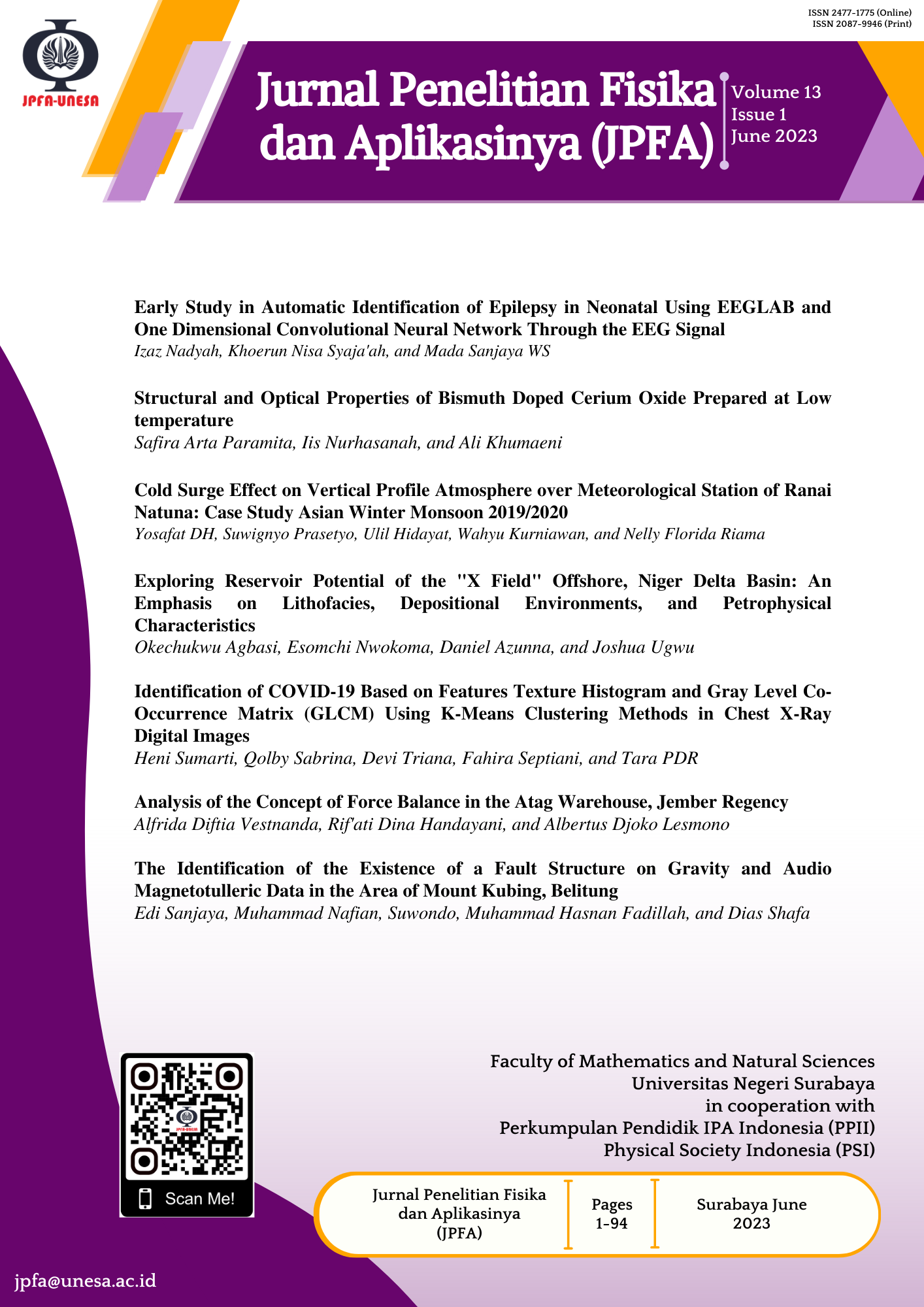Identification of COVID-19 Based on Features Texture Histogram and Gray Level Co-Occurrence Matrix (GLCM) Using K-Means Clustering Methods in Chest X-Ray Digital Images
DOI:
https://doi.org/10.26740/jpfa.v13n1.p51-66Keywords:
COVID-19, CXR, Histogram, GLCM, K-Means ClusteringAbstract
Since the last five years of the COVID-19 outbreak, radiological images, such as CT-Scan and Chest X-Ray (CXR), have become essential in diagnosing this disease. However, limited access to facilities such as CT-Scanners and RT-PCR makes CXR images the primary method for COVID-19 testing. This research aims to improve the accuracy of CXR images in identifying COVID-19 patients based on the texture features: histogram and Gray Level Co-occurrence Matrix (GLCM), using the K-Means Clustering method. This study utilized 150 CXR images, including 75 COVID-19 patients confirmed by RT-PCR tests, and 75 patients with negative cases. The method used were consisted of pre-processing, and texture feature extraction with the seven most influential attributes based on gained information (histogram: standard deviation, entropy, skewness, kurtosis, and GLCM: correlation, energy, homogeneity), as well as classification using K-Means clustering methods. The results showed that the classification’s accuracy, sensitivity, and specification are 92%, 91%, and 93%, respectively. This image processing technique is a promising as well as a complementary tool in diagnosing COVID-19 cases, based on CXR images with lower costs and more reliable results.
References
Ozsahin I, Sekeroglu B, Musa MS, Mustapha MT, and Ozsahin DU. Review on Diagnosis of COVID-19 from Chest CT Images Using Artificial Intelligence. Computational and Mathematical Methods in Medicine. 2020; 2020: 9756518. DOI: https://doi.org/10.1155/2020/9756518.
Falaschi Z et al. Chest CT Accuracy in Diagnosing COVID-19 During the Peak of the Italian Epidemic: A Retrospective Correlation with RT-PCR Testing and Analysis of Discordant Cases. European Journal of Radiology. 2020; 130: 109192. DOI: https://doi.org/10.1016/j.ejrad.2020.109192.
Hare SS et al. Validation of the British Society of Thoracic Imaging Guidelines for COVID-19 chest radiograph reporting. Clinical Radiology. 2020; 75(9): 710.e9-710.e14. DOI: https://doi.org/10.1016/j.crad.2020.06.005.
Maulida N, Paramitha DF, and Sukarno EA. Klasifikasi Kanker Paru-Paru Menggunakan Pengolahan Citra. Jurnal Teknik Pomits. 2013; 2(1): 1-4.
Nugroho A. Klasifikasi Nodul Tiroid Berbasis Ciri Tekstur pada Citra Ultrasonografi. Thesis. Unpublished. Yogyakarta: Universitas Gajah Mada; 2015.
Witten IH, Frank E, Hall MA, and Pal CJ. Data Mining: Practical Machine Learning Tools and Techniques 4th Edition. Massachusetts: Morgan Kauffman Pub; 2017. DOI: https://doi.org/10.1016/C2015-0-02071-8.
Younis DB and Younis BMK. Low Cost Histogram Implementation for Image Processing using FPGA. IOP Conference Series Material Science and Engineering. 2020; 745: 012044. DOI: https://doi.org/10.1088/1757-899X/745/1/012044.
Hussain K, Rahman S, Rahman M, and Khaled SM. A Histogram Specification Technique for Dark Image Enhancement Using a Local Transformation Method. IPSJ Transaction on Computer Vision and Applications. 2018; 10(3): 3. DOI: https://doi.org/10.1186/s41074-018-0040-0.
Brown S. Measures of Shape: Skewness and Kurtosis. Available from: https://brownmath.com/stat/shape.htm.
AndonoPN, Sutojo T, and Muljono. Pengolahan Citra Digital. Yogyakarta: CV. Andi Offset; 2017.
Eko B. Metodologi Penelitian Kedokteran: Sebuah Pengantar. Jakarta: EGC, 2004.
Sacher RA and McPherson RA. Tinjauan Klinis Hasil Pemeriksaan Laboratorium. Jakarta: ECG; 2004.
Downloads
Published
How to Cite
Issue
Section
License
Copyright (c) 2023 Jurnal Penelitian Fisika dan Aplikasinya (JPFA)

This work is licensed under a Creative Commons Attribution-NonCommercial 4.0 International License.
Author(s) who wish to publish with this journal should agree to the following terms:
- Author(s) retain copyright and grant the journal right of first publication with the work simultaneously licensed under a Creative Commons Attribution-Non Commercial 4.0 License (CC BY-NC) that allows others to share the work with an acknowledgement of the work's authorship and initial publication in this journal for noncommercial purposes.
- Author(s) are able to enter into separate, additional contractual arrangements for the non-exclusive distribution of the journal's published version of the work (e.g., post it to an institutional repository or publish it in a book), with an acknowledgement of its initial publication in this journal.
The publisher publish and distribute the Article with the copyright notice to the JPFA with the article license CC-BY-NC 4.0.
 Abstract views: 479
,
Abstract views: 479
, PDF Downloads: 545
PDF Downloads: 545









